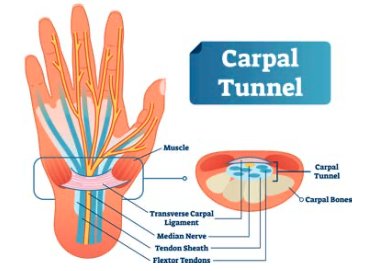Do you experience numbness or tingling in your hand, particularly of the thumb, index and middle fingers?Do you drop items, especially when you try to pinch? Does your palm hurt to touch? Do you find yourself shaking your hand to gain relief from these symptoms, most notably during the night? You might have carpal tunnel syndrome (CTS).
The carpal tunnel is a narrow passage formed by your carpal, or wrist bones. These bones form the floor of the tunnel while a thick fibrous tissue band creates the roof. The median nerve and muscle tendons that help flex your fingers pass through this tunnel, where they are protected. However, because this space is small, if the tendons become swollen or thickened, the nerve can become compressed and cause CTS. CTS usually develops slowly and remains persistent. When the tendons thicken from overuse they require additional space, leaving less room for the nerve. Swelling has the same effect. Less commonly, a local fracture or infection, a tumour, or an underlying disease like arthritis or diabetes, can also reduce space and cause this condition. Symptoms The symptoms are due to reduced median nerve function. This nerve provides feeling, and enables muscles to contract. So, when compromised, these functions are affected. The median nerve supplies sensation to more than half of the palm, the thumb, index and middle fingers; so you may experience tingling, numbness and pain in these areas. Sometimes it can be a sensation like a mild electric shock. The pain can extend up the forearm. The motor part of the median nerve is responsible for movement of the thumb so, when harmed, weakness can occur. This can contribute to poor pincer grip strength – potentially making it difficult to hold a cup, twist jar lids, write, even do up buttons and put in earrings. When severe, the muscular mound at the base of the thumb can waste away. How does CTS happen ? While there are biological factors that increase risk, like being female and pregnancy, there are other factors that can be addressed. Occupational stressors play a role. Repetitive bending of the wrist and exposure to hand-transmitted vibration elevates risk, making assembly line workers, cashiers, drillers, meat packers, computer workers, and sewers more vulnerable. So a safe, ergonomic work space and reduced awkward wrist and hand postures are helpful. If CTS does occur, treatment options are available. The use of a splint to maintain a neutral wrist position may help. An exercise program that targets arm and shoulder circulation, flexibility, and power can restore reduced grip strength. Carpal tunnel syndrome can be disabling, so prevention is key. If you think you may be at risk of developing carpal tunnel syndrome, speak to your Adam's Back chiropractor about the best preventative measures for you.
1 Comment
|
AuthorAdam's Back is a team of dedicated complimentary health professionals. Our aim is to support you in finding drug-free solutions for better health. Archives
July 2024
Categories |
Search by typing & pressing enter


 RSS Feed
RSS Feed